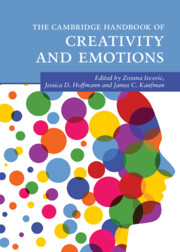Book contents
- The Cambridge Handbook of Creativity and Emotions
- Cambridge Handbooks in Psychology
- The Cambridge Handbook of Creativity and Emotions
- Copyright page
- Dedications
- Contents
- Figures
- Tables
- Contributors
- Acknowledgments
- Creativity and Emotions
- Part I Methods in the Study of Creativity and Emotions
- Part II The Development of Creativity
- Part III Emotions and the Creative Person
- 12 Emotion Traits and Creativity
- 13 Gender Differences in Creativity and Emotions
- 14 Affect in Pretend Play and Creativity
- 15 Creativity, Emotions, Emotion Regulation, and Aging
- 16 Interpersonal Relationships, Social Emotions, and Creativity
- Part IV Emotions and Creative Products
- Part V Emotions and Creativity at School and Work
- Index
- References
15 - Creativity, Emotions, Emotion Regulation, and Aging
Older Adults Take on Life’s Challenges with Creativity and Finesse
from Part III - Emotions and the Creative Person
Published online by Cambridge University Press: 16 February 2023
- The Cambridge Handbook of Creativity and Emotions
- Cambridge Handbooks in Psychology
- The Cambridge Handbook of Creativity and Emotions
- Copyright page
- Dedications
- Contents
- Figures
- Tables
- Contributors
- Acknowledgments
- Creativity and Emotions
- Part I Methods in the Study of Creativity and Emotions
- Part II The Development of Creativity
- Part III Emotions and the Creative Person
- 12 Emotion Traits and Creativity
- 13 Gender Differences in Creativity and Emotions
- 14 Affect in Pretend Play and Creativity
- 15 Creativity, Emotions, Emotion Regulation, and Aging
- 16 Interpersonal Relationships, Social Emotions, and Creativity
- Part IV Emotions and Creative Products
- Part V Emotions and Creativity at School and Work
- Index
- References
Summary
We consider the important roles played by creativity and emotional intelligence in enhancing the success of older persons in dealing with stressors and adaptive tasks of later life. These cognitive and interpersonal skills can maximize late life adaptations, including competent functioning in the face of chronic illnesses, social losses, and care-getting needs.
Keywords
- Type
- Chapter
- Information
- The Cambridge Handbook of Creativity and Emotions , pp. 280 - 298Publisher: Cambridge University PressPrint publication year: 2023



